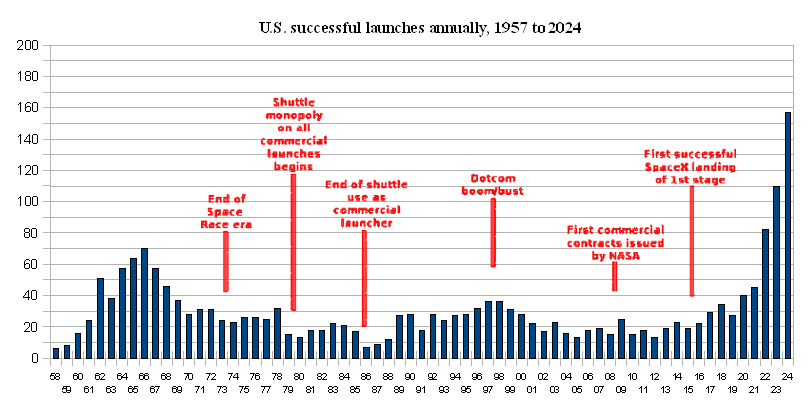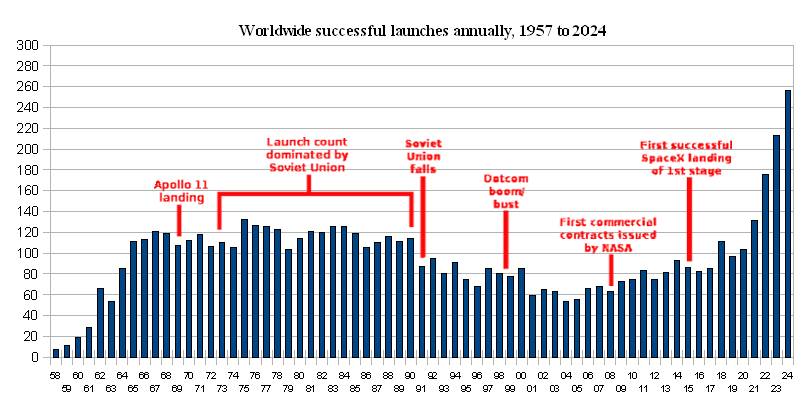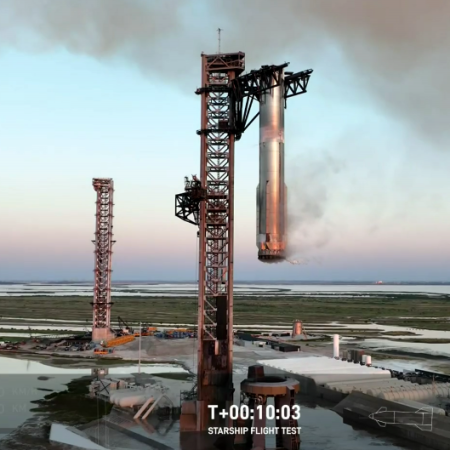The global launch industry in 2024: A year of amazing highs and depressing lows, with the best yet to come
For the past five years the entire global rocket industry has experienced a revolution that has resulted in a rise in global launch numbers unprecedented since the launch of Sputnik in 1957. 2024 was no different, with the total number of successful launches topping 256, two to four times the average number of launches that had occurred yearly prior to 2020.
This success has almost entirely been driven by the arrival of many private rocket companies competing for government and commercial business — led largely by SpaceX — aided by the decision by governments worldwide to get out of the way and let private enterprise do the job. The result has been spectacular, so much so that it now seem possible in the very near future to see humans finally revisiting the Moon and even getting to Mars and the asteroids.
At the same time, 2024 saw some significant signs that this success is not guaranteed, and could vanish in an instant if care is not taken.
The graph below, my annual count of launches world wide, provides the groundwork for these conclusions.

To understand however the specifics hidden in this graph — both the highs and the lows — requires some further detailed analysis. Let us begin in the U.S., which at present is the world’s leader in rocketry.
The American launch industry in 2024
In the United States, this bi-polar phenomenon of highs and lows was most pronounced. For the high we had SpaceX setting a launch record more than a third higher than the record it had set the year before. In fact, its 137 successful launches in 2024 exceeded the annual total for the whole world from Sputnik in 1957 until 2020. SpaceX so dominated the industry that its 137 launches exceeded the rest of the entire global launch industry combined, including American companies.
Imagine: A single American private company launched more than every other nation and company combined, in the entire world. If a science fiction writer had proposed this twenty years ago no one would have considered the idea plausible.
The two graphs below further highlight the impact SpaceX has had on worldwide and American launches in just the past three years.



Superheavy after its flight, safely captured at Boca Chica
on October 13, 2024.
This stupendous rise in annual launches is directly related to SpaceX’s introduction of re-usability. It can now launch almost daily, and in fact in 2024 it almost did so. In a sense, SpaceX has made its Falcon 9 launch operations almost as efficient and as routine as ordinary airline operations.
The company then topped its Falcon 9 re-usability achievements with the absolutely astonishing success at catching a Superheavy booster on the very first attempt. Nothing like this had every been done before. And yet, the company made it almost seem easy — something it most certainly was not.
SpaceX’s domination however should not blind us to the successes of others. Rocket Lab almost doubled its orbital launches in 2024, and if we include its two suborbital launches using only its Electron rocket’s first stage, dubbed HASTE, it actually did so.
Meanwhile ULA achieved a major milestone with the first two launches of its Vulcan rocket, intended to replace its Delta and Atlas-5 rockets. Overall it did not see a great increase in launches, but the arrival of Vulcan sets the stage for the company’s prediction of 20 launches in 2025.
Those are the American highs. The lows however are very discouraging. First, the war in the Ukraine has caused Northrop Grumman to lose its ability to launch its Antares rocket because it used a Ukrainian first stage. The company is now waiting for Firefly to replace that stage, but the delay has caused it to pause all launches.
Blue Origin in turn once again failed to complete the first orbital launch of its New Glenn rocket, though it has now very close to doing so at last. As of this moment it appears the company is targeting a January 6, 2025 launch. If successful, the company might finally in 2025 complete the six New Glenn launches it has been promising each year for the past five. And once it does so, this big re-usable rocket will definitely be able to compete successfully with SpaceX’s Falcon 9,
The other rocket failures however are more significant. In 2021 the U.S. had a plethora of new rocket companies, all on the verge of launch and all primed to dominate the global launch industry. Instead, one by one they have exited the field. Relativity completed one unsuccessful orbital launch of a small rocket only to immediately abandon that rocket to focus on a larger version, pushing back its next launch attempt until 2026. ABL shut down its commercial rocket operations after several launch and testing failures, switching its focus to providing hardware to the military. Astra abandoned its small rocket after several successes and failures, and after struggling with cash flow issues has at this point left the field. Virgin Orbit went bankrupt when red tape in the United Kingdom prevented it from launching for more than a half year, causing serious cash flow problems that became mortal when that launch failed.
Aevum meanwhile has drifted into obscurity. It had announced plans to achieve its first launch in 2020, then 2021, and then silence. Though the Space Force in August 2024 included it in its list of companies permitted to bid on launch contracts, there have been few signs in more than two years whether the company is doing anything any longer.

The FAA, where rockets die of bureaucratic red tape
Behind all these failures has lurked the burdensome new Part 450 regulations introduced by the FAA in the spring of 2021 to supposedly “streamline” its licensing process. By all accounts, it has ended up choking these new companies to death. Numerous sources have suggested to me that many long delays these new regulations cause acted to discourage investment, which is partly why Relativity, Astra, and ABL have had money problems. These same regulations have made life very hard for the already established companies like SpaceX and Rocket Lab, significantly slowing development of SpaceX’s Starship/Superheavy, and possibly explaining why Rocket Lab has abandoned its effort to recover and reuse the first stage of its Electron rocket.
Whether the new Trump administration will have the courage to cancel these odious regulations, ripping power from these bureaucrats, remains to be seen. I think it certain however that Elon Musk has made this issue clear to Trump in their many conversations.
For the rest of the world, 2024 saw some similar ups and downs, though the contrast was not as extreme, and most of the positive events were related to smart changes in policy, not actual launches.
The big space powers outside of America: China, Europe, and Russia
China continues its steady but rising pace in launches. Though it failed to reach its predicted 100 launches in 2024, it still saw an increase, even as it introduced a number of new rockets while continuing to expand operations at its five spaceports. Its pseudo-capitalist policies, which allow Chinese citizens to form companies that compete for business, has served it well. The unknown for this system is that it could instantly vanish with a change of government, as the property rights of all of these pseudo-companies are not really protected by law. For the moment however it has made China a space powerhouse, with several of these pseudo-companies on the verge of launching re-usable first stages in 2025.

Positive change at the European Space Agency
In Europe 2024 brought about a major but positive change in policy. Though the year saw the fewest European launches in two decades, only three, this failure merely illustrated why the European Space Agency (ESA) and its member nations began in 2024 the aggressive transition from its government-run Arianespace launch monopoly to the capitalist model, whereby ESA and those member nations purchase launch services from many competing private rocket companies. As a result 2024 saw the appearance of about a dozen new rocket startups, with several very close to their first launches. In addition ESA took away Arianespace’s launching rights to the Vega-C rocket that the Italian rocket company Avio builds. From now on, Avio itself will market and launch the rocket. The government middle-man has been eliminated.
You can read a very good summary of the status of all these European rocket startups by Andrew Parsonson at the European Spaceflight website, posted yesterday. I don’t entirely agree with his rankings, but his list is quite complete and accurate. Overall it suggests that Europe is moving quickly to grab the market share the U.S. could have owned, had our government not squelched those new rocket companies during the Biden administration.
Russia meanwhile continued its long decline, completing only seventeen launches in 2024, its second lowest annual total since the early 1960s. The previous low, 15 launches in 2018, was caused by specific quality control problems within the aerospace industry controlled entirely by Roscosmos. In 2024 the low count was more fundamental. Russia no longer has any international customers (due to its invasion of the Ukraine), and its cash flow and overall technical capabilities are declining. It might still recover, but all signs say otherwise. Putin’s decision to consolidate the entire industry into Roscosmos, controlled by the government, has eliminated all competition. There are no incentives to do better.
The rest of the world: India, Japan, Iran
While this lower tier of nations ranks far below the big powers, there are signs that this low ranking could significantly change quite soon, especially in India.

India’s spaceports
India’s launch rate continues to lag, caused by the decision of its space agency ISRO to shut down for almost two years during the COVID panic. During that time others continued to fly, and thus were able to grab India’s commercial market share, which India has not been able to recapture. Like Europe, however, 2024 saw a strong effort in the Indian government to shift from the government-run model to the capitalist model. Two private rocket startups, Agnikul and Skyroot, have completed suborbital test launches, and both are bidding to take over ISRO’s SSLV rocket. The government is also pushing to have private companies take over its larger PSLV rocket as well as build for ISRO its spacecrafts and rockets.
Like NASA in 2010s, a turf war within the government is taking place, with the old bureaucracy fighting this change. And like NASA, it will likely take a decade for the shift to play out,
Japan has been attempting the same policy shift, with the Japanese government establishing in 2023 a large fund to encourage private development. So far however its space agency JAXA has done little to distribute this fund as planned, instead holding control within its own confines. Outside of this program one private rocket startup, Space One, twice attempted its first test launch in 2024, but both launches failed.
We should not count Japan out as a future major player, but at this moment that possibility seems somewhat far in the future.
Iran meanwhile was a surprise, its four successful orbital launches in 2024 suggesting it is serious about developing a rocket capability. The purpose however remains mostly military, providing reconnaissance and surveillance, and whether it can be sustained is questionable. The Islamic leadership of Iran is presently under great financial and political pressure. Its survival remains uncertain.
Conclusion
Despite the lows of 2024, the highs suggest that next year will probably be the most exciting in space since beginning of the space age in the 1950s.
In the U.S. not only will SpaceX continue its high pace of launches, it will likely face some real competition with both Vulcan and New Glenn entering the market. In addition, Rocket Lab intends to introduce its larger re-usable Neutron rocket that will compete with them all. And all of this effort will be further fueled by the first launches of Amazon’s 3,200+ Kuiper satellite constellation, requiring numerous launches from ULA’s Vulcan, Blue Origin’s New Glenn, Europe’s Ariane-6, and SpaceX’s Falcon 9. In addition the expected launch later in 2025 of the first of four private space stations, Haven-1, will supplement this demand. Those stations will need rockets to launch and supply them.
In China the launch pace will likely rise as its pseudo-companies begin introducing their own re-usable rockets needed to launch two Chinese giant satellite constellations of 13,000 and 14,000 satellites respectively. China also has ambitious plans to send missions to other planets, as well as upgrade and expand its space station. All that will require a gigantic number of rockets and launches.
In Europe expect the new rocket startups to make progress. Several should fly their first orbital test missions.
In India the pace will also pick up, as that country hopes in 2025 to launch its first manned mission. Even more important to its launch industry is the planned launch of the first module of India’s own space station in 2028. Like all the others, this station will require rockets and capsules to be launched and maintained, and the Indian government seems determined to have its private sector provide that service.

In 2017 I wrote a policy paper for a Washington think tank, Capitalism in Space [pdf], that strongly advocated this capitalist, freedom-based model. I concluded as follows:
A close look at these recommendations will reveal one common thread. Each is focused on decentralizing power away from the government and increasing the freedom of U.S. companies to act as they see fit to meet the demands of the market. The key word that defines this common thread is freedom, a fundamental American idea that fueled this country’s phenomenal growth from a small number of tiny colonies huddled on the East Coast of the North American continent to become the most prosperous nation in the history of the world.
…Freedom is actually a very simple idea. Give people and companies the freedom to act, in a competitive environment that encourages intelligent and wise action, and they will respond intelligently and wisely.
The United States proved this works by its past history. It is time we proved it again, in the future – in space.
It increasingly appears that the world is doing so, which makes the future bright for the exploration and colonization of the entire solar system.
On Christmas Eve 1968 three Americans became the first humans to visit another world. What they did to celebrate was unexpected and profound, and will be remembered throughout all human history. Genesis: the Story of Apollo 8, Robert Zimmerman's classic history of humanity's first journey to another world, tells that story, and it is now available as both an ebook and an audiobook, both with a foreword by Valerie Anders and a new introduction by Robert Zimmerman.
The print edition can be purchased at Amazon or from any other book seller. If you want an autographed copy the price is $60 for the hardback and $45 for the paperback, plus $8 shipping for each. Go here for purchasing details. The ebook is available everywhere for $5.99 (before discount) at amazon, or direct from my ebook publisher, ebookit. If you buy it from ebookit you don't support the big tech companies and the author gets a bigger cut much sooner.
The audiobook is also available at all these vendors, and is also free with a 30-day trial membership to Audible.
"Not simply about one mission, [Genesis] is also the history of America's quest for the moon... Zimmerman has done a masterful job of tying disparate events together into a solid account of one of America's greatest human triumphs."--San Antonio Express-News


Robert wrote: “China continues its steady but rising pace in launches.”
I would argue that China has reached a plateau. It may be only temporary. It may be due to a lack of payloads to launch, but as Robert noted, the number of payloads should increase greatly once China’s com-sat constellation is ready for launch. It may be due to a limited ability to manufacture the launch vehicles, but as Robert noted, as China adopts reusable launch vehicles into their fleet then there should be plenty of available launch vehicles. It may be due to their launch pads not being designed for high launch cadences, and that could be a problem for them.
“… which makes the future bright for the exploration and colonization of the entire solar system.”
Which brings up a previous post by Robert:
Robert would like to look not at our mere return to the Moon with what we have now, but he wants to look at a much larger picture, a long-term view of what we do in space. To him, we need not beat the Chinese to the Moon (of course, we already have, so why would we think we need to again), but we should create the hardware and a space industry that does much, much more than that one goal.
https://behindtheblack.com/behind-the-black/essays-and-commentaries/part-2-of-2-de-emphasize-a-fast-moon-landing-and-build-a-real-american-space-industry-instead/#comments
“The primary goal of Artemis should therefore not be to land humans on the Moon, but to first create a multi-faceted American space industry focused on competition and free enterprise, doing many different things. Such a goal would result in the kind of robust capabilities that would allow Americans and American industry to dominate the solar system for centuries.
“Isaacman should therefore focus on the using all the remaining assets of Artemis — as well as the fleet of space stations that private American companies are presently building to replace the ISS — to build a sustainable real space-faring industry in Earth orbit that will quickly expand outward naturally to the Moon and beyond.” [emphases in original]
Would Jared Isaacman do this as NASA administrator? After all, going back to the Moon through Artemis was ordered by Trump, so both men may keep that program as is. On the other hand, the plan does not seem to match reality. The Orion spacecraft will still not be ready for operations on its first manned operational flight. NASA has decided to make that first manned flight a kluge, with a heat shield that does not work as intended and a life support system that has yet to be tested in orbit. The reason that after two decades these are unprepared for operational use on Orion is that the launch vehicle is rarely available and costs a king’s ransom to fly. And Artemis seems unlikely to get U.S. astronauts onto the Moon within Trump’s second term as president.
Would SLS still be useful for Robert’s proposed goal, or for any goal, for that matter? No. Due to its expense and its infrequent availability it is not useful for anything productive. Maybe the occasional specialized deep space probe, but would that probe have the budget for such an expensive launch vehicle? It is a capable rocket, but its expense and scarcity harm its usefulness. SpaceX’s Starship has similar capabilities, is much more available, and costs a fraction of a penny on the dollar. All these were requirements from the beginning of Starship’s design.
One problem is that NASA does not get the budget to do both goals, going to the Moon and building a real space-faring industry. If NASA continues Artemis to the Moon, then American industry will be largely on its own to build a sustainable space-faring industry. After half a century of government control over space activities, the world’s established space industry is ill prepared for the task of building an independent space-faring industry, and the startups do not yet have the experience and reputations to obtain the funding to fully accomplish this task in this decade. Even if all these companies were able to do this, could that industry develop the picture that we want? Would the government-run NASA, were it funded to do so? NASA hasn’t so far, and I have little confidence it would start now, even with Isaacman attempting to convince Congress to fund this proposed new goal.
If Congress does not go along with this new goal, can Isaacman find another way to achieve a similar result? Can he find funds to hire the commercial space stations to do work that prepares the U.S. for supporting an industry that does the majority of the space-fairing activities?
Another problem is that the larger picture requires more than just Starship. Many people are fascinated with SpaceX, and for good reason, as this one company has moved us far into the direction of frequent yet inexpensive access to space by using reusable launch vehicles (The Space Shuttle was supposed to do this half a century ago). Starship should be able to frequently and at low cost lift massive payloads and (if I may misuse a word) voluminous payloads into low Earth orbit and take massive and large payloads to Mars and back. Those two are the main goals of Starship — what it is designed to do. However, how good is it at reaching other destinations?
I think that for us and our discussions on Behind the Black (BtB), at least for now, is to not focus on the hardware we have now but to focus on just what it is that we want to do in space. What we want to do will inform us as to the hardware we need. Starship seems so wonderful, because it was designed for specific tasks — impressive tasks. SLS seems so dreadful, because it was designed for no specific task.
What is it that we want from space exploration, space manufacturing, and space utilization? Do we want space stations that rotate, providing an artificial gravity similar to what Disney and von Braun showed us? Do we want space-based solar power generators beaming energy down to ground stations to power our activities on Earth? Do we want space Colonies like those imagined by Gerard K. O’Neill? Do we want moon bases on the Moon, as many artist’s conceptions have shown us? Do we want space telescopes and space radio telescopes? Do we want asteroid mining, similar to the Sean Connery movie Outland? Do we want to find space aliens, similar to the Sigourney Weaver movie Alien? Do we want to flood the Earth with a trillion dollars worth of precious minerals from 16 Psyche (the asteroid reportedly worth a trillion dollars)? What have I missed from this list of possibilities?
We may be able to fund all of these from eager investors, but they will be most eager to fund the things we want, the things we will pay for.
What about some of the fantasies of science fiction, where the Earth’s population is greatly reduced, allowing the environment to heal from the terrible things that we have not yet done to the planet? It looks like the prosperous countries have already reduced their birthrates below replacement levels, initiating this science fiction proposal, but these same nations are accepting immigrants from the poorer countries, only to discover that they bring lawlessness with them. It seems that if we are to achieve the dreams of science fiction, we must do it with greater care.
The real decisions will come from the space industry, from the companies that build the hardware that will do what it is that we want, but their decisions will be influenced by what is profitable, by what We the People are willing to buy from space. Electricity? Pharmaceuticals? Exotic metals and materials? We already buy telecommunications from space companies and some amount of weather information from government satellites.
Our experience with ISS suggests that a space station may have a life expectancy of three decades. Modern earthbound buildings have a life expectancy of 40 years, although with proper maintenance they can last significantly longer, like the New York skyscrapers they built a century ago. Can we find a way to get our space stations to last longer than ISS, to last a century or more?
This is the right time to think about these types of questions, because the companies beginning to do business in space right now are the ones that are going to have the greatest influence in what we do in space and what we get from space in the next decade. What these companies do in the next decade will influence what we do and get from space for the following few decades.
A broad look right now at the big picture is a good idea. We have our dreams. We know where we have been. We know where we are right now. Where are we headed, and do we want to go there, or do we want to go somewhere else?
Edward: Excellent essay with many great points. One thought however. You write, “I think that for us and our discussions on Behind the Black (BtB), at least for now, is to not focus on the hardware we have now but to focus on just what it is that we want to do in space.”
Considering what this audience of space geeks want sounds good, but it seems to me more important to consider what the customers who buy space products want. Even more important, it is essential the space industry create products that others want. They aren’t going accomplish anything if they do it just to fulfill their own wants.
An excellent recap of the year. Thank you. I can’t wait to see what 2025 brings.
We need to support the people who are trying to figure a way of making money in Space instead of from the taxpayers.
Musk has already doe this with Starlink but it doesn’t require bodies “up there”.
I think a case can also be made based on political motivations. No one in DC will say this out loud but in the gap between an economic case there is this possibility:
If the Chinese establish themselves they need to do the same but I’m afraid they don’t have a traditional entrepreneurial culture and will settle on building “wall” on orbit and charging people for access or some such scheme. They are traditionally isolationist. They like to claim territory and exclude others.
If the West doesn’t have a “permanent” presence in Space or LEO after the ISS burns up, it will give them an opportunity to do mischief.
Most informative and entertaining!
Ps. Suggest “If a science fiction writer HAD proposed this twenty years ago…”
Robert: Your first chart shows a rightmost column of “2024 Predicted.” Don’t you mean 2025 predicted?
Michael McNeil: No. Those were the numbers these companies and nations predicted they’d achieve in 2024. I did not include a column for the 2025 predictions this year.
Ray Van Dune: Fixed. That’s what my brain had thought I had written. Thank you.
Although it will be nice to have competition for SpaceX I think at first neither the New Glenn nor Vulcan are going to take much of SpaceX business. Their efforts are likely to be single digit numbers in 2025. I would venture to say there will be more Spaceship/Superheavy launches next year than the combination of Vulcan and New Glenn. Bezos is still focused on Blue Origin so for the moment there is money. In addition New Glenn’s larger fairing will be able to attract customers which won’t fit inside a Falcon 9 or Falcon Heavy. ULA has serious issues they’ve been looking for a suitor/white knight in 2024. In addition they are dependent on Blue Origin for the BE-4 engines which have been slow to appear. Finally there doesn’t seem to be reusability in the Vulcan model, trying to compete with Falcon 9’s lower costs will be hard. Maybe if Starship goes operational SpaceX will move most of its Skylink traffic there. and leave some of their non skylink traffic to Blue Origins/ULA as they’ll likely phase out falcon 9 other than in the Falcon Heavy form..
Although the U.S. commercial space industry is vibrant, NASA is still spending vast sums of money on SLS / Orion. With the advent of a White House-connected Elon and a SpaceX-connected NASA Director, the possibility that SpaceX vehicles will assume bigger roles in Artemis is very real.
The evolution of Artemis, and the advent of SpaceX playing the long pole in the program, could be quite exciting both technically and politically!
Tregonsee314: While your pessimism for both Blue Origin and ULA in 2025 is certainly justified, you forget that both companies have large multi-launch contracts with Amazon to put its Kuiper constellation in orbit, and a large percentage of those launches must occur in the next 18 months for Amazon to meet its FCC license requirements. Those contracts call for the following:
Once Amazon begins delivering satellites this year, expect ULA to quickly push to complete a lot of launches. I expect Blue Origin will do about a third of its total, while Arianespace will do about the same. SpaceX of course will get its three launches off when scheduled.
I also forgot to add the contracts ULA and Blue Origin have with the U.S. military. Those launches have to occur quickly also.
Robert Zimmerman,
Thank you for the compliment. I have been thinking about this for the past couple of weeks, and that is what came out. I’m still thinking. This is a fascinating topic, and I want to explore it much more. We are now seeing the kind of action in space that I had expected the Space Shuttle to bring, at the beginning of my career. I have missed some of the excitement I thought I would help produce. Still, I got to do some interesting projects, and that keeps me happy.
“Considering what this audience of space geeks want sounds good, but it seems to me more important to consider what the customers who buy space products want. Even more important, it is essential the space industry create products that others want. They aren’t going accomplish anything if they do it just to fulfill their own wants.”
I like the way you think. As we read the news and watch various programs, we could become aware of possible products that may sell or be desirable, giving us good topics for discussion. One benefit of having eight billion people on the planet is that no one person has to think of all the good things that we can do in space. There are billions of other opportunities for good ideas.
For instance, Joe is building smallsats. Joe is building smallsats! He gets to build them for customers who want to do great things in space at a reasonable cost. How wonderful is that? He gets to help usher in the future.
__________________
Tregonsee314 wrote: “Although it will be nice to have competition for SpaceX I think at first neither the New Glenn nor Vulcan are going to take much of SpaceX business. Their efforts are likely to be single digit numbers in 2025.”
Good point, but I doubt SpaceX fears much for its Falcon business. As Robert noted, there is a rapidly expanding customer base, and the world’s launch companies need to get busy satisfying these needs. This is why Robert’s count of annual launches is so exciting. Each year the world needs and gets more launches into space. It is a useful measure of how much more we do in space than ever before. Total number of active satellites, annual upmass, number of satellites launched, amount of revenue generated by using these satellites are other good measures of the expanding business of space.
SpaceX may be using Falcon as a means to an end, as they use Starlink. SpaceX’s goal is Mars, and the Falcons are not the main driver for that goal, but they were excellent training grounds for learning to develop Starship. SpaceX may not mind that the Falcons become obsolete and are replaced by other launchers, such as Neutron, New Glenn, and Vulcan. It would allow them to focus more on their true goal.
Tregonsee314,
I’ll echo our host ZimmerBob in noting that ULA and Blue Origin have a lot of pending launch contracts to fulfill – contracts whose payloads can be fairly easily shifted to SpaceX’s Falcons should either or both ULA and Blue stumble badly in 2025. Both firms have considerable incentive to get their respective launch cadences up – or, in Blue’s case, to establish a cadence at all. The first quarter of 2025 should be quite instructive in this regard. Personally, I have the feeling that SpaceX will wind up doing rather more than three launches for Amazon by the time all is said and done.
On the subject of the future for SpaceX’s Falcons, it is, I think, not fated to be one of imminent eclipse. Instead, I foresee the Falcons continuing to increase their cadence through at least 2030 and the de-orbiting of ISS. SpaceX has contracts for Falcon services – including the actual de-orbiting mission itself – all through the next five to six years. And, if SpaceX must keep the Falcons in service that long, it will fly them as frequently as it can in order to minimize the contribution of fixed overhead costs to each launch and thereby maximize operating profits.
That will be particularly true for Starlink launches. Starship will ramp up deployments of the really big Starlink birds as quickly as possible, but the size of Starlink’s customer base is now limited by the total thoughput of the constellation. And, while the big Starlinks will be more profitable than the smaller ones, the latter will still be profitable overall. Thus, it makes sense to keep putting up the smaller birds too, at least until the constellation reaches its maximum authorized size in terms of units on-orbit. At that point, replacement with more capable birds becomes the whole game and Starship should be better suited to that job. But that point seems unlikely to be reached until at least the same 2030 which is to see the demise of ISS.
Beyond 2030, the role of the Falcons may well end. But, in the interim, their operational economics seem well able to resist any significant inroads by potential competitors based on price. Vulcan will never be price-competitive with the Falcons even if ULA’s SMART partial re-use ever becomes a thing. The price-competitiveness potential of New Glenn also looks iffy based on Blue’s traditional tendency to scratch-build gold-plated manufacturing and launch infrastructure. Perhaps Rocket Lab’s Neutron can push the Falcons on price a bit, but even that seems far from certain.
Bottom line? Don’t expect any near-term de-emphasis on – never mind any end to – Falcon ops by SpaceX.
Starship may deploy Starlinks soon even if there are recovery problems.
I hope that frees up Falcon launches—which are still dominated by Starlinks.
Dick Eagleson wrote: “Personally, I have the feeling that SpaceX will wind up doing rather more than three launches for Amazon by the time all is said and done.”
I agree. I would be surprised in 2025 if Amazon’s Kuiper makes a good pace on launching its constellation using its currently contracted launchers. Kuiper relies upon several new launch vehicles, but in the past new launchers have typically taken more that a year to get a good cadence going.
“And, if SpaceX must keep the Falcons in service that long [through at least 2030], it will fly them as frequently as it can in order to minimize the contribution of fixed overhead costs to each launch and thereby maximize operating profits.”
If the price tag on a Starship launch is low enough, and if Starship’s cadence becomes high enough, I can see the Falcon launches come down in price, with Starship and the Falcons in competition with each other. Although profits are important, SpaceX emphasizes low cost to orbit, and this could be another opportunity to advance that goal, too.
____________________
Thinking about this decade, so far:
We lost the space station maker, Bigelow. We had been counting upon that company to create a non-ISS destination for Cygnus, Dragon, Dream Chaser, and Starliner. Instead, we have to wait until later this year, losing half a decade of commercial space station competition with ISS. I expect the rules for using commercial space stations to be far less onerous than NASA’s rules for using ISS, allowing for better trade secrecy, and for commercial profits to be made, greatly expanding the demand for space station use.
We didn’t get Starliner, at least not in the way we expected. If Dragon is flying at its maximum cadence (if its turnaround time is now minimized), then we are losing opportunities for commercial manned space exploration that Starliner could have been supplying. Either way, Boeing is losing revenue from Starliner that it should have had, all because the company has made a plethora of mistakes with this design. A lesson for us all.
Robert noted in his essay that we have lost several smallsat launch companies. This is tragic, as it reduces the number of opportunities for smallsat launches, and it reduces the competition in this part of the industry. It also reduces the rate at with we will get future larger launch vehicles, because these companies are now out of the running.
We are getting scores of satellite operators flying their own research and tests in space. Most often these are smallsats performing research, tests, and operations on the cheap. They get much of the same things done, but they cost less and they launch earlier than large satellites. They can become operational faster and they can operate profitably. The smallsat (below 2,000 kg) is quickly becoming the workhorse in space.
Despite the half-decade delay getting commercial space stations to orbit, there have been several commercial manned orbital flights, so far all of them have performed some form of research or development testing and none have been tourist flights. This demonstrates the pent-up demand for industrial manned spaceflight over the demand for space tourism. A decade ago, we thought that space tourism would be the major driver for commercial manned flights, but it is not. Suborbital flights are the only ones finding customers for space tourism (although some consider activities such as Disney’s “Space Tours” ride and commercial “vomit comet” rides to count as space tourism, as they simulate aspects of spaceflight).
Commercial space is making headway to landing on the Moon, about a decade later than Google’s X-Prize. These companies are learning the hard way how complicated their software is, the difficulties of integrating all the parts of their spacecraft and payloads, and the foibles of changing plans mid-project.
A decade ago, The Martian showed us that getting man to Mars would be an expensive herculean project, because no one was taking Robert Zubrin’s “Mars Direct” plan seriously. Now Zubrin’s plan is the basic tenet of SpaceX’s plan, and SpaceX seems to be half a decade or so from executing that plan.
https://en.wikipedia.org/wiki/Mars_Direct
One company is sending its own probe to an asteroid to help develop asteroid mining. Another company has already returned orbitally manufactured pharmaceuticals. Launch costs are decreasing, and operating costs have become affordable. This decade hasn’t been as good as I had expected, but it is doing very well. Now that We the People are taking control of space, we are finally getting what we want from it.